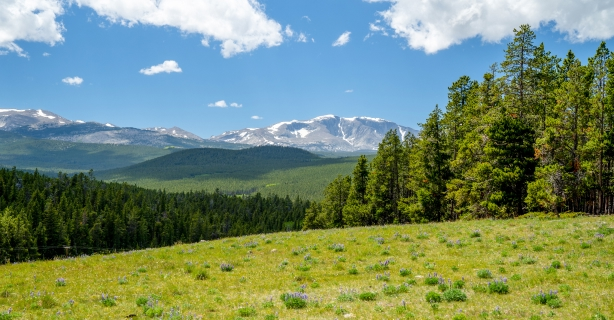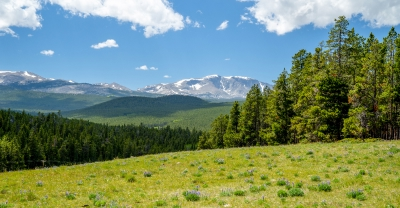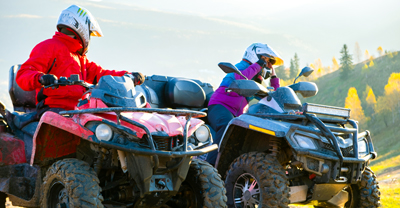Bighorn National Forest ATV riding guide


0 min. read
Bighorn National Forest is a favorite destination for off-road riders—from ATV and UTV owners to seasoned 4x4 drivers—looking for high-altitude terrain and big Wyoming views. But there’s more to enjoy than just throttle time. With hundreds of miles of motorized routes, panoramic overlooks, and overnight options for camping or cabin stays, this national forest offers room to roam and reasons to return.
Whether you’re a local rider or hauling in from out of state, here’s what to know to plan your next off-road trip.

Get a quote for flexible off-road vehicle insurance.
Bighorn National Forest ATV route map
To avoid getting off track, download the official Motor Vehicle Use Map (MVUM) from the U.S. Forest Service. The Avenza Maps app is a popular tool that works offline and allows you to track your route with GPS—no cell service needed.
When selecting trails, look for those marked as open to vehicles 50 inches wide or less for true ATV access.
Weather in Sheridan, Wyoming
Many riders choose to stay in Sheridan while exploring Bighorn National Forest. The city offers easy access to the park along with lodging, restaurants, and supply stops. Of course, camping is also available throughout the forest if you want to stay closer to the trailheads.
If you're planning an off-season trip, keep in mind that many roads and routes are closed during the winter and spring months due to wet or snowy conditions. Most years, the best riding season runs from May through October—though that can vary depending on snowfall and elevation. It's always a good idea to check current closures and trail conditions before you travel.
To help you pack and prepare, here’s a look at average monthly temperatures in Sheridan:
ATV safety while riding in the Bighorn Mountains
The Bighorn Mountains are known for rugged, scenic rides—so it’s important to be prepared and stay aware on the trail. Here are a few key considerations for a safe and enjoyable trip:
Watch for wildlife
Moose, elk, and bighorn sheep are common—and large. Keep your distance, especially during spring calving (May–July) and fall mating season (September–December), when they may act more aggressively.
Stay alert
Many OHV trails are shared with hikers, horseback riders, and other users. Slow down when visibility is limited or the trail is narrow.
Pack essentials
Bring water, layers, and a basic repair kit—weather can shift quickly at higher elevations.
Know your terrain
Many Bighorn trails include steep climbs, rocky surfaces, and exposed sections. Be sure to match your route to your skill level and take extra care in rugged or high-altitude areas.

Start your free ATV insurance quote today!
What else to do in Bighorn National Forest
Riding might be the main draw, but Bighorn National Forest has even more to discover. If you’re staying for a few days, there’s plenty to explore beyond the trails. Add a few of these stops to your itinerary:
For history buffs
People have lived in and traveled through the Bighorn Mountains for thousands of years, leaving behind a rich cultural and archaeological legacy. The area officially became the Big Horn Forest Reserve in 1897, and was renamed the Bighorn National Forest in 1908. If you're drawn to historic places and the stories behind them, you’ll find plenty to explore here.
Medicine Wheel/Medicine Mountain National Historic Landmark (NHL): A sacred Native American site and archaeological treasure open to the public.
Sheep Mountain Lookout: A historic fire lookout offering panoramic views. It’s accessible by trail and motorized vehicles under 50 inches wide.
Tie Hack sites: Explore remnants of the region’s historic railroad tie industry at Tie Hack Campground, Reservoir, and Flume.
For overnight stays
There are dozens of camping areas and cabin rentals throughout Bighorn National Forest—many of which are near OHV trail access points. Some sites can be reserved in advance, while others are available on a first-come, first-served basis. Amenities range from primitive to modern, so you can plan your stay based on the season, your riding plans, and your comfort level.
Campgrounds: From Bald Mountain’s wildflower views to Owen Creek’s or South Fork’s OHV-friendly layout, you’ll find plenty of places to pitch a tent. Look for the "OHV" symbol when choosing a campground to make sure off-road vehicles are welcome.
Cabins: Several rustic cabins are located near OHV-friendly areas, including Pole Creek Cabin and Muddy Guard Cabin—bookable through Recreation.gov. Availability varies, so check reservation options and access details before you go.
ATV coverage for your Bighorn ride
Whether you’re exploring public trails or hauling your ATV to Bighorn and beyond, ATV insurance can help protect you and your investment. Dairyland®, a brand of the Sentry Insurance Group, offers flexible off-road coverage options. If you want extra protection on your adventures, we can help—call us at 866-287-9640 to explore your options.

Get a free ATV insurance quote today.
The general information in this blog is for informational or entertainment purposes only. View our blog disclaimer.














